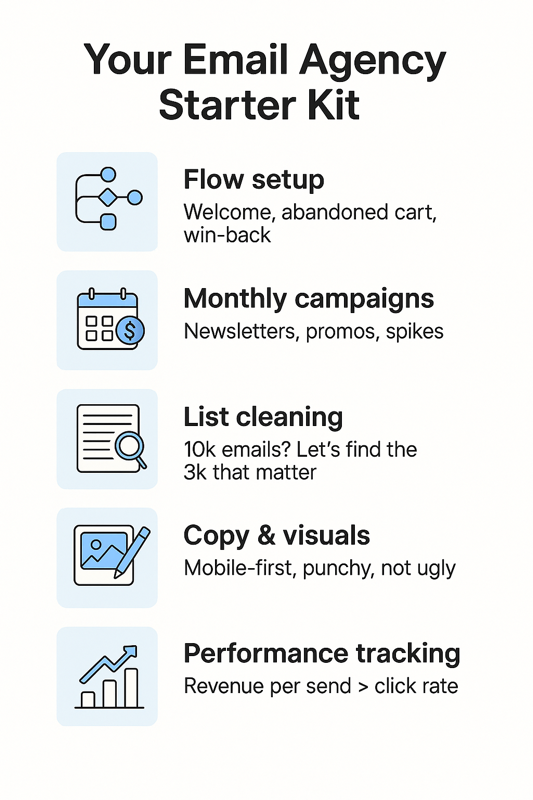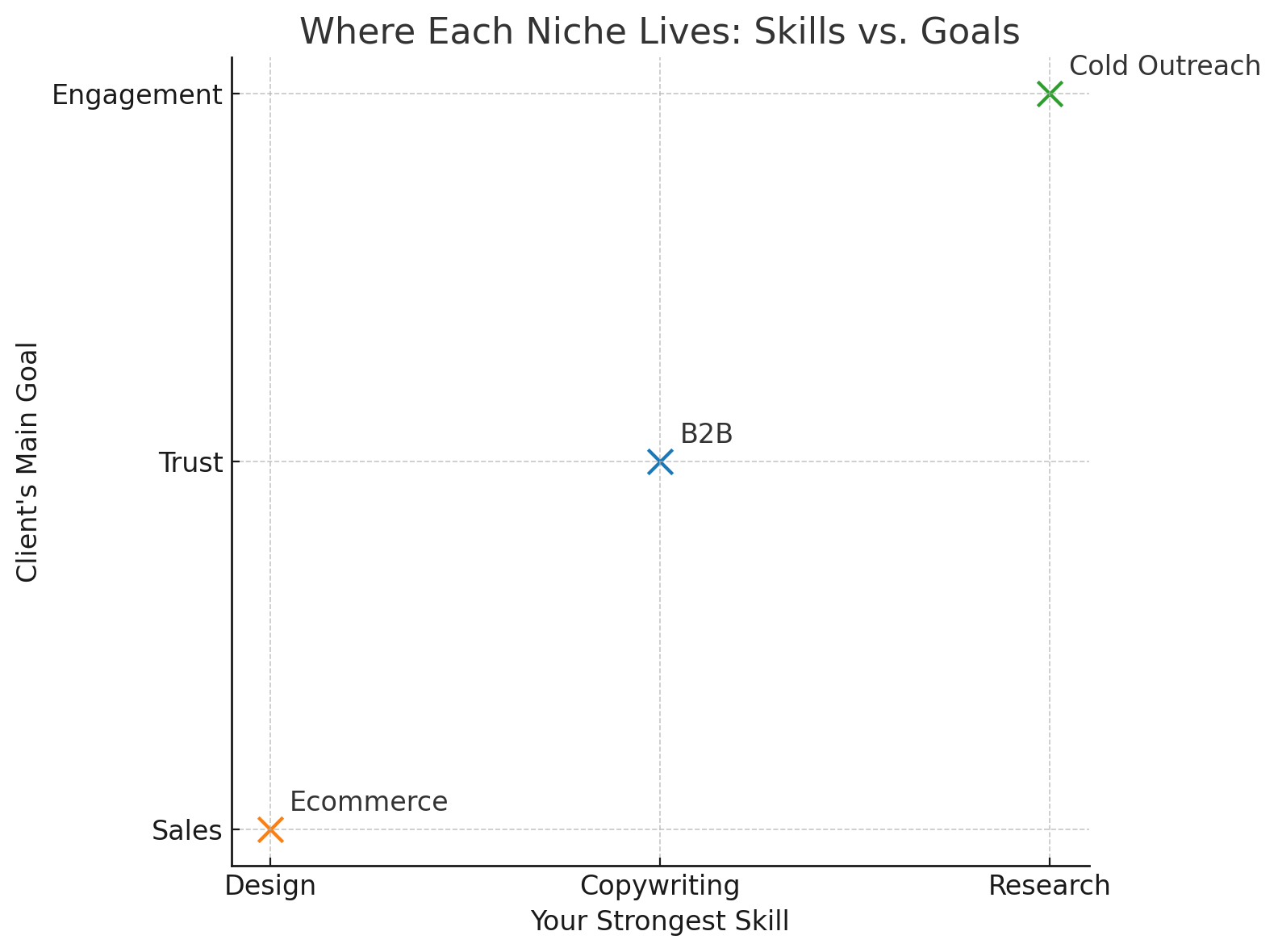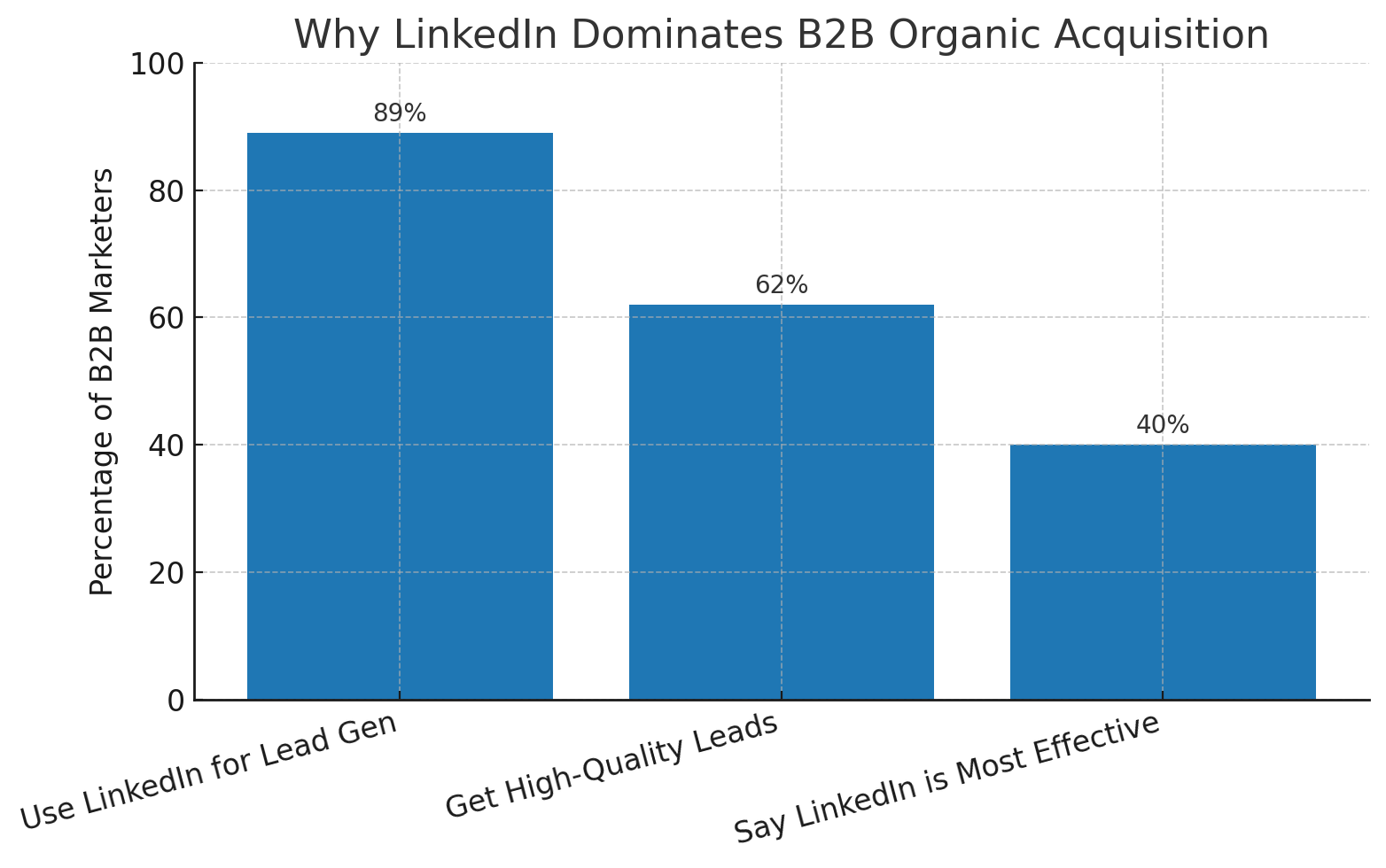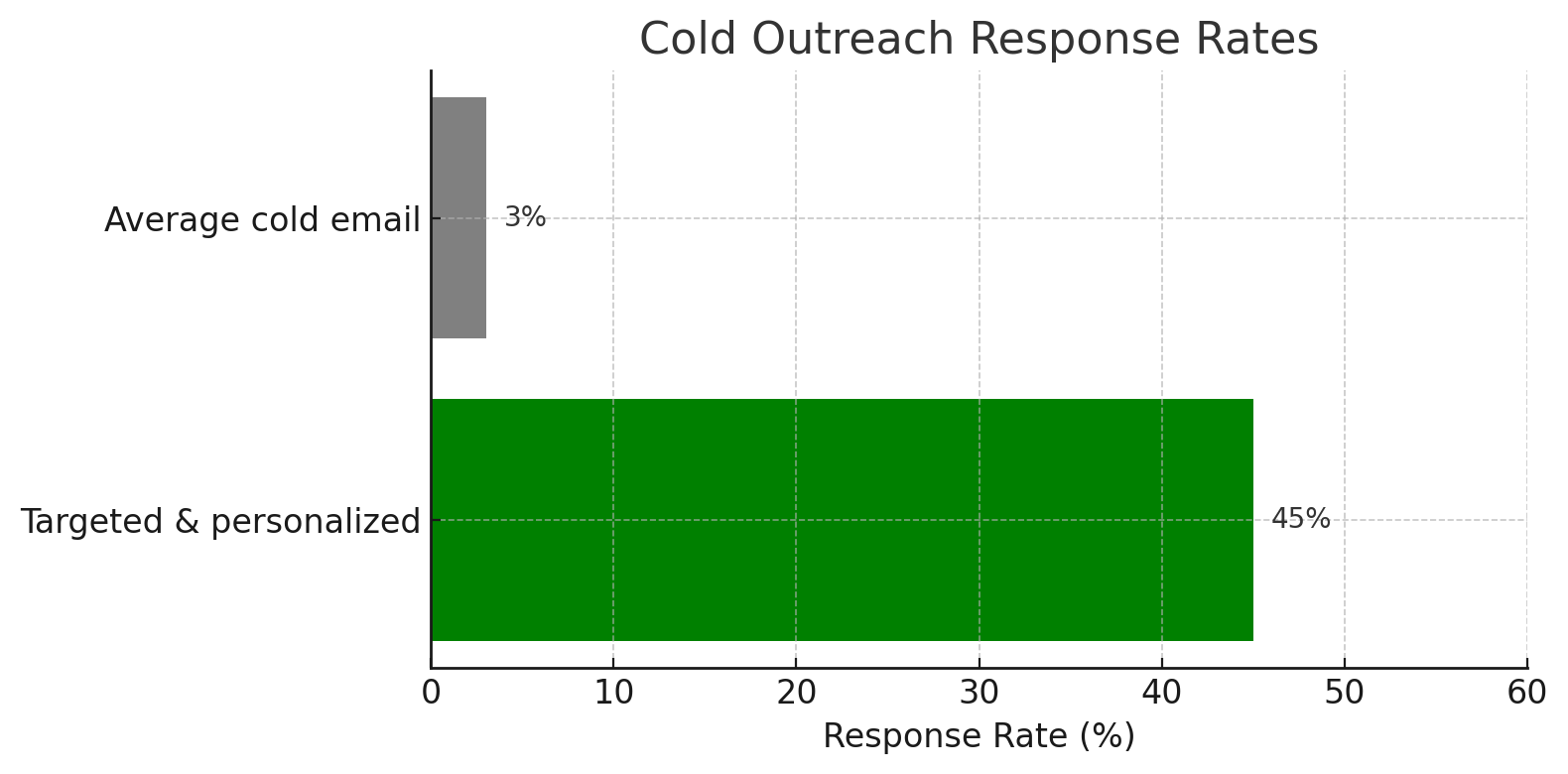Starting an email marketing company today doesn’t mean renting an office, hiring a team, or spending months building a brand. In 2025, it’s more about clarity than scale. You pick a lane, learn how to drive real results for a narrow group of clients – and then show up in the right places where people are already looking for help.
Upwork happens to be one of those places. So if you’re wondering how to turn your copywriting or automation skills into a real service – like the best email marketing agencies do – and land your first few contracts, this guide breaks it all down.
What You Actually Need to Start an Email Marketing Agency
You don’t need a team, a fancy website, or years of experience to start. You need a laptop, an internet connection, and a clear understanding of what you’re offering – and to whom.
Most people overcomplicate this. They think they have to build an “agency” before they start working. In reality, most early-stage agencies are solo operators doing client work, sending invoices, and learning on the go. That’s normal. No one’s checking for your LLC.
And yet the opportunity is massive: the global email marketing industry is projected to surpass $12 billion in revenue by the end of 2025, with average ROI reported at $36–$42 per $1 spent. Over 80% of businesses actively use email as a core channel – and many of them outsource it.
What does matter is your ability to write good emails, set up flows, and understand how email fits into a business. That’s what clients care about. They’re not hiring a brand – they’re hiring results.
To start, you need two main things:
- An offer you can confidently deliver – welcome flows, abandoned carts, promos, newsletters. Start with what you know or are willing to learn fast.
- A way to get clients – you’ll learn more by doing real work than by studying theory. That’s why we recommend Upwork if you’re starting from zero. You’ll get live briefs, real feedback, and a chance to test your pitch in the wild.
Nail those two, and you’re already doing better than 90% of people who say they want to start.
Let’s walk through how to start your email marketing business – step by step.
Step-by-Step Guide to Launching Your Agency from Scratch
There’s a point in the process where you stop thinking about “starting an agency” and start doing the work. That’s what this section is about.
It doesn’t matter if you’ve got the perfect logo or a shiny website. What matters is that clients know what you offer and feel like working with you won’t be a headache. Everything else is noise.
Let’s walk through what actually moves you forward.
1. Pick a name and create a simple identity
Don’t overthink this. Use your name if needed. Just grab a clean domain, set up a basic Gmail or custom email, and create a Calendly link so people can book a call. You don’t need branding at the first stage – you need to be reachable.
2. Set up your working stack
Clients will expect deliverables, reports, and comms. Set up:
• A client-facing Gmail or Notion workspace for reports.
• A project tracker (Notion or Trello is enough).
• A folder structure on Google Drive or Dropbox.
• A basic invoice template (Google Docs or Wave).
No need to automate everything right now – just make sure you’re not reinventing the wheel every time.
3. Build 1–2 packages you can clearly explain
Start lean. One package for email setup (welcome flows, basic automations). One for ongoing campaigns (monthly newsletter, product promos). You’ll evolve them later, but for now, just make them simple enough to pitch in two lines.
Don’t price yet – we’ll get to that later.
4. Get a case study or test project (even if unpaid)
If you haven’t worked with a client yet, offer to set up flows for a friend’s store, a local business, or your personal brand. Record what you did. Track the open rates, CTRs, or revenue from flows if possible. That one win will anchor your proposals later.
5. Write out how you work
This part is underrated. Just draft a doc explaining what happens after a client says yes. How do you onboard? What do you need from them? When do they get emails? What’s the delivery format?
Even if no one sees this doc yet, it makes your offer feel real – because now you have a process, not just vibes.
At this point, you’re not just “thinking” about launching an agency – you’re running one. The pieces are there, even if it’s just you and a Google Sheet for now.
Let’s keep building. You’ve got the foundation – now let’s talk about the services clients actually expect you to deliver.
Email Marketing Agency Services to Include in Your Packages
When you’re just starting, it’s tempting to say “I can do everything.” But that’s usually a red flag for clients – and a fast track to burnout. A better approach is to offer a tight set of services you can clearly explain, deliver well, and price without guessing.
Here’s what should be in your starter kit.
1. Flow setup and automation
This is the bread and butter. Welcome series, abandoned cart flows, post-purchase, win-back. These aren’t just nice to have – they drive revenue on autopilot. Your job is to understand the logic, write the emails, and connect the dots inside stack the client uses.
2. Monthly campaigns
Think newsletters, promos, product drops, or event announcements. These are one-off sends that keep lists warm and generate spikes in traffic or sales. For some clients, this will be your main role. For others, it’s a bonus add-on.
3. List cleaning and segmentation
Many clients come to you with a 10k list – and no clue what’s inside. Helping them clean dead weight, segment by behavior or tags, and build smart audiences is one of the easiest ways to deliver instant value.
4. Copywriting and visual layout
Most founders don’t have time (or skill) to write emails that convert. If you can write clean, punchy copy and build layouts that don’t break on mobile – you’ve got an edge. Bonus points if you know your way around product images, buttons, and basic mobile optimization.
5. Performance tracking and reporting
Clients want to know if your emails are working. Set up basic KPIs: open rate, click rate, revenue per send. Create simple dashboards or just drop results in a Notion page. If you can explain what’s working and what needs fixing, you become more than a freelancer – you become their email brain.

You don’t need to offer all of this from day one. But as you grow, these services form the core of what most clients expect from an email marketing partner – whether they’re B2B, DTC, or running cold email funnels.
Up next, we’ll break that down even further – and help you pick the niche that best fits your skills and goals.
Define Your Niche and Offer
Before you start designing email flows, it helps to know exactly who you’re talking to. “I’ll do email marketing for everyone” sounds easy in theory, but in practice, it makes it harder to get traction. You’ve probably heard that before, but here’s how to make it work now, when you’re just starting. The more specific your niche, the faster you’ll land clients, even if you later expand or mix directions. It also makes it easier to position yourself as the obvious choice.
Let’s look at three of the most common types of email marketing agencies and how to think about each one.
B2B Email Marketing Agency
If you’ve ever helped a SaaS, consultant, or B2B startup with lead gen or nurture sequences, you’re already close to this niche. It’s less about design and more about clarity, timing, and understanding the sales cycle. These clients want newsletters, onboarding, and lifecycle emails that support a long buying process. And they’re usually fine with plain-text formats – as long as they convert.
This path rewards people who understand value props, storytelling, and objection handling. If you enjoy writing more than designing, B2B is usually a great fit.
Ecommerce Email Marketing Agency
Here, everything’s about the funnel. Think: abandoned carts, welcome flows, product announcements, loyalty loops. Ecommerce brands want flows that drive revenue and match their brand voice. A/B testing, upsells, segmentation – all of it matters.
If you can write in a tone that doesn’t sound generic, you’ll find lots of opportunity here. Just keep in mind that many brands already have flows set up – your edge is in improving what’s there, not just creating from scratch.
On Upwork, ecommerce flows and cold outreach campaigns pop up daily.
Cold Email Marketing Agency
This is its own beast. You’re not writing newsletters – you’re writing mini-pitches to strangers. That means deep research, sharp hooks, and short copy that gets replies. Most founders think they can write cold emails themselves, until they don’t get responses.
Clients here don’t just want nice formatting; they want meetings on the calendar. If you’ve got a background in sales or copywriting, this niche can be a fast way to build proof, especially with smaller clients who just want leads.

Once you’ve picked your niche and defined your offer, everything else gets easier – from picking tools to crafting proposals. Next, let’s talk about the ones you’ll actually want to master.
Best Tools to Master (Klaviyo, Mailchimp, etc.)
You don’t need to be a tool nerd to start. But knowing which platforms matter – and when to use them – will save you hours (and a few awkward client calls).
Let’s break it down by what clients expect in 2025:
• Klaviyo – still the king of ecommerce email.If you’re aiming to become a Klaviyo email marketing agency or work with Shopify brands, get comfortable with flows, segments, and campaign logic here.
• Mailchimp – legacy, but still used by smaller businesses and agencies. Knowing how to set up automations and clean lists in Mailchimp is like knowing how to drive stick – basic, but handy.
• HubSpot & ActiveCampaign – more common in B2B setups. You don’t need to master them early on, but understanding their workflow logic helps when pitching or auditing.
• Instantly.ai / Smartlead – essential for cold email agencies. These tools handle sending, warmup, and inbox rotation. Clients often expect you to set them up or advise.
• Notion / Airtable / Google Sheets – not email tools per se, but crucial for tracking campaigns, reporting, and syncing with clients without the back-and-forth.
Don’t try to learn everything at once, and start with one tool per niche (e.g., Klaviyo for ecommerce, Instantly for cold outreach) and build out from there.
Mastery isn’t knowing every setting – it’s knowing what to do when something breaks.
Next up, let’s talk money. We’ll cover how to price your services without underselling yourself – and without scaring off first clients.
How to Price Your Email Marketing Services
Email marketing agency pricing isn’t just about guessing what the client can afford. It’s about knowing the value you bring and presenting it in a way that feels clear and fair to both sides. And in 2025, that means moving past generic retainers and building offers people actually understand.
The biggest shift? Clients today don’t just want emails – they want outcomes. So if you’re still charging per email or per word, you’re going to lose to someone who charges for revenue growth from flows or lead gen from sequences. You’re not a writer – you’re a revenue builder, and your pricing should reflect that.
Here’s how most freelancers approach it when starting out:
They package services into either project-based pricing (like setting up a welcome flow for $300–$800), or monthly retainers (like $1,200/month for ongoing campaigns + flows). Both work, but only if you explain what the client gets in real business terms. Not “4 emails/month.” Think: “2 campaigns and 1 flow setup targeting winback customers.”

As you grow, your pricing should shift from what you do to what it delivers. For example, ecom freelancers often move to a rev-share model after a few successful months – say, a base retainer of $1,500/month plus 5% of flow-attributed revenue. That makes the deal feel collaborative instead of transactional. And it’s a lot easier to scale when your income grows with the client’s.
If you’re working with B2B, things look a bit different. Cold email and lead gen is more performance-driven, so many charge per booked call or use a hybrid model, like a base fee of $1,000 plus $100 per qualified lead. The key is clarity: clients don’t mind paying for email marketing consultancy if they know exactly what they’re getting (and it’s something they actually need).
The goal isn’t to be the cheapest. It’s to be the easiest yes for the right kind of client by showing them what results they’ll get, what they’ll pay, and why it’s worth it.
Next up – you’ve got the offer. But how do you actually get people to say yes? Let’s talk about getting your first clients without begging or underpricing.
How to Get Your First Clients
When you’re just starting out, it’s easy to feel like getting your first client is a game of luck. But it’s usually not. Most people just don’t know where to look – or how to stay consistent once they start. Here are four real ways people land their first few clients in 2025, and how you can do the same.
Organic: Content, LinkedIn, Twitter
Organic reach still works. Especially when you’re offering a specialized service like email marketing.
You don’t need to be a “content creator.” You just need to look like you know what you’re doing. Post simple case studies, cold email teardown threads, or short tips with screenshots.
On LinkedIn, the numbers speak for themselves: 89% of B2B marketers actively use LinkedIn for lead generation, and 62% say it actually generates quality leads for them. Plus, 40% of B2B marketers rate LinkedIn as the most effective channel for high‑quality leads. That’s why real stories about problems you’ve solved, even hypothetical ones, can get people to DM you.

If you’re just launching your LinkedIn presence, check out this guide on the best LinkedIn lead generation tools for B2B success in 2025 – it walks through proven automation and outreach platforms, from Sales Navigator to Dripify.
Twitter (or X) works better for building in public and joining agency/solopreneur convos. Follow email founders, growth people, and other freelancers – and don’t be afraid to jump into threads. That’s how most people get DMs.
The key with organic is signal. If your profile clearly shows what you do and who you help, you’re already ahead.
Cold Outreach: Emails, Looms, Offers
Cold outreach works if you approach it like a human.
Don’t just send “Hi, we offer XYZ” spam. Find real people who actually might need email marketing – early-stage SaaS, ecom brands with no welcome flow, coaches doing launches. Send a short message, record a Loom walking through their current setup, and explain what you’d change.
Focus on offers, not just services. “Let me write you a 3-email welcome flow for $100” sounds better than “We do email marketing strategy and copywriting.”
And yes, people still reply. In fact, 2025 benchmarks show average cold email response rates range from 1% to 5%, with highly targeted, personalized campaigns hitting as high as 40–50% reply rates. That means if your outreach doesn’t feel human or relevant, you’re probably landing in junk, but when it’s done right, real conversations happen.

Marketplaces: Upwork, Fiverr, Contra, Toptal
Marketplaces are noisy, but they work if you learn how to play the game.
Upwork is by far the best place to start if you’re doing email marketing. It holds over 61% market share among freelance platforms, with more than 18 million freelancers and around 850,000 active clients as of 2025. Clients there already know what they want, and there’s a steady stream of jobs.
Contra and Fiverr can work too, but they’re more price-sensitive. Toptal is only worth trying once you’ve built a solid track record.
What makes the biggest difference? Your profile, your proposal, and your speed. When you’re early, you won’t win based on experience. You win by showing you get it – and by applying while others are still hesitating.
We’ll dive deeper into this in the next section – and show how to turn Upwork from a job board into a predictable lead machine.
Partnerships & Referrals
Even if you’re new, you can build referral loops.
Reach out to web designers, brand strategists, funnel builders – people who work with the same clients you want. Offer to handle their clients’ emails. In many cases, they’ll be happy to pass work your way (or white-label your service).
This also works with past colleagues or friends in related roles. Just don’t make it transactional. Focus on helping first, and referrals will come more naturally.
Daily Habits to Stay on Top of Job Feeds
Finding clients is a habit.
Every day, block out half an hour – just enough time to scroll through new jobs, reply to a few DMs, maybe drop a proposal or comment on a LinkedIn post. Keep your past pitches handy, jot down who you’ve already messaged, and don’t let things pile up. It’s not glamorous, but doing this on autopilot is how the pipeline quietly builds itself.
A pipeline doesn’t build itself. But if you treat outreach and visibility like brushing your teeth – something you do no matter what – you’ll always have leads coming in.
Now we’ll go deeper into Upwork: how to write a profile that gets clicks, proposals that get replies, and how to filter out low-quality jobs (without spending all day scrolling). If you’re serious about getting your first few clients, this is where things start to click.
How to Get Your First 10 Clients on Upwork
Getting one job on Upwork is one thing. Turning it into ten – that’s when it starts to feel real.
The good news? You don’t need to “hack the algorithm” or outbid everyone. You just need to consistently show that you understand what clients want and can actually deliver it.
Let’s start with your profile. Most people treat it like a résumé, but clients aren’t hiring credentials – they’re hiring clarity. If your title says “Email Marketing Specialist” and the first two lines explain who you help and what problems you solve, you’re already ahead of half the feed. No fluff, no “hard-working freelancer passionate about growth.” Just signal. If they can skim your profile and immediately think “yep, this one gets it,” you’ve done your job.
Next comes your proposals. This is where most people lose the thread. A proposal isn’t a biography – it’s a mirror. You’re reflecting back the client’s problem, showing that you get it, and offering one simple next step. That might be a suggestion for a flow, a short breakdown of what’s missing, or even a link to a 2-min Loom. The trick is not sounding like ChatGPT wrote it. Talk like a human, keep it short, and skip the “Dear Sir or Madam” energy.
Now, if you’re new and have no reviews, you might wonder how to build trust. That’s where micro-testimonials come in. Even if you’ve only helped a friend with their email flows, get a quote. Screenshot it. Add it to your profile or attach it to a proposal. It’s not about faking it – it’s about showing that someone, somewhere, got results from working with you. That proof, even in small doses, makes a big difference.
Finally, don’t waste hours replying to bad-fit jobs. If a posting is vague, underpriced, or looks like a fishing expedition, skip it. The goal isn’t to apply to 50 jobs a day – it’s to apply to the 3–5 you actually want. That way, you can write better pitches, move faster, and protect your energy. Save links to quality clients. Create filters that surface new jobs early. And treat proposal writing like a skill, because it is.
Once you’ve got the first few wins, momentum kicks in. Clients refer you, invite you, and trust you faster. That’s how you shift from scraping jobs to picking them.
Want proof it works? Here’s one real story of agency growth on Upwork.
Case Study: From Zero to Clients in 90 Days
Let’s break down what it actually looks like when an agency goes from nothing to a working client pipeline on Upwork.
This story started with a clean slate: no reviews, no case studies, no hired history. The agency created a new profile, narrowed its offer to a specific email marketing service, and spent the first few days just observing job feeds and analyzing what kind of offers actually got hired.
We helped them test different proposal angles, pricing formats, and CTAs. One version clicked: a short intro, 1–2 past results (even if from personal gigs), and a clear offer – “Want a 2-minute audit?”
That’s when replies started coming in.
By week 2, they were already jumping on intro calls. By the end of month one, two closed deals.
From there, we layered in a basic system: saved job searches, organized lead tracking, proposal templates, and a Notion board for follow-ups.
By day 90, they weren’t just getting clients. They were scaling, using white-label partners to handle delivery while they doubled proposal volume.
👉 Full breakdown: How GigRadar helped a digital agency land 25 clients on Upwork
And that’s where scaling starts to look real. Let’s talk about that next.
White Label Email Marketing: A Smart Way to Scale?
Let’s say you’ve landed a few clients, things are stable, and you’re doing most of the delivery yourself. It’s manageable, but it’s also your ceiling. There’s no way to grow without either hiring, burning out, or disappointing clients. This is where white label comes in.
The core idea is simple: you sell the service, someone else fulfills it. But what actually works in practice?
In 2025, white label isn’t just about finding a random freelancer on Upwork and hoping for the best. It’s about building repeatable, low-friction collaboration with someone who already works like an agency, but doesn’t want to deal with sales. Think: boutique teams in Eastern Europe, LATAM, or Southeast Asia with 3–5 people and deep Klaviyo or cold email experience. They don’t advertise, but they love consistent flow.
The easiest way to start is with fulfillment-only partnerships. You bring the client and the strategy. They do the build-outs, automations, copy, segmentation, or cold email sprints, depending on the vertical. You handle client comms, revisions, and upsells. Everyone wins.
But to make it work long term, you need process. Shared templates. Shared expectations. Clear timelines and scope per task. Ideally, a Notion or ClickUp that acts like your own internal ops manual. It can still be lean – just not chaotic.
Also, don’t confuse white label with outsourcing your core value. If your edge is strategy, don’t give that away. If your edge is copy, own it. Use white label to free yourself from what’s repeatable, not what’s irreplaceable.
If done right, you get to scale delivery without hiring – and still keep margins in the 40–60% range.
Some agencies never hire a full-time team at all. They just plug into smart fulfillment engines and keep growing as client-facing operators. That’s a valid path too.
The key is not in delegating everything – it’s in knowing what you can productize without diluting your brand.
But there’s one more unlock: automating what you still do manually – like finding jobs, tracking follow-ups, and writing proposals. That’s where systems like GigRadar come in.
How GigRadar Can Help You Land More Clients on Upwork
Let’s be honest: finding leads takes time. Not the fun kind of time – the scroll-for-an-hour-and-get-nowhere kind.
That’s where GigRadar makes a difference. It filters out lowball offers, spammy gigs, and tire-kickers, so you only see the jobs actually worth your pitch. No need to refresh feeds every hour or keep tabs open all day – qualified leads come to you.
It’s not just a time-saver. It’s a system for getting consistent work, especially when you’re building momentum and don’t want to burn out chasing every maybe.
Once the projects start coming in, you’ll need email marketing software for agencies to keep everything running smoothly.
If you’re serious about Upwork, it’s worth having GigRadar in your corner.




.webp)
.webp)
.webp)
